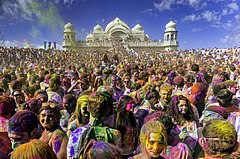Holi
Appearance
The "Scots" that wis uised in this airticle wis written bi a body that haesna a guid grip on the leid. Please mak this airticle mair better gin ye can. (Dizember 2020) |
| Holi | |
|---|---|
 Holi celebration | |
| Observed bi | Hindus,[1] Sikhs, some Jains an aw,[2] Newar Buddhists[3] an ither non-Hindus[4] |
| Teep | releegious, cultural, ware festival |
| Celebrations | Nicht afore: Holika Bonfire On Holi: spray colours on ithers, dance, pairty; eat festival delicacies[5] |
| Date | per Hindu calendar[note 1] |
| Frequency | Annual |
Holi (Sanskrit: होली Holī) is a ware festival, kent as the festival o colours or the festival o love an aw.[9][1] It is an auncient Hindu releegious festival which haes acome popular wi non-Hindus in mony pairts o Sooth Asie, as well as fowk o ither commonties ootside Asie.[10]
Notes
[eedit | eedit soorce]- ↑ Syne auncient times, the Indie subcontinent haes haed several major Hindu calendars, that places Holi an ither festivals on different local months even tho thay mean the same date. Some Hindu calendars emphasise the solar cycle, some the lunar cycle. Faur, the regional calendars featur twa tradeetions o Amanta an Purnimanta seestems, whaurin the seemilar soondin months refer tae different pairts o a lunar cycle, sicweys faur diversifeein the nomenclatur. The Hindu festival of Holi faws on the first (full muin) day o Chaitra lunar month's daurk fortnicht in the Purnimanta seestem, while the same exact day for Holi is expressed in Amanta seestem as the lunar day o Phalguna Purnima.[6] Both time measuring and dating systems are equivalent ways of meaning the same thing, they continue to be in use in different regions.[6][7] In regions whaur the local calendar places it in its Phalguna month, Holi is cried Phaguwa an aw.
References
[eedit | eedit soorce]- ↑ a b The New Oxford Dictionary of English (1998) ISBN 0-19-861263-X - p.874 "Holi /'həʊli:/ noun a Hindu spring festival ...".
- ↑ Kristi L. Wiley (2009). The A to Z of Jainism. Scarecrow. p. 42. ISBN 978-0-8108-6337-8.
- ↑ Bal Gopal Shrestha (2012). The Sacred Town of Sankhu: The Anthropology of Newar Ritual, Religion and Society in Nepal. Cambridge Scholars Publishing. pp. 269–271, 240–241. ISBN 978-1-4438-3825-2.
- ↑ Lyford, Chris (5 Apryle 2013). "Hindu spring festivals increase in popularity and welcome non-Hindus". The Washington Post. New York City. Retrieved 23 Februar 2016.
Despite what some call the reinvention of Holi, the simple fact that the festival has transcended cultures and brings people together is enough of a reason to embrace the change, others say. In fact, it seems to be in line with many of the teachings behind Holi festivals.
- ↑ Holi: Splashed with colors of friendship Archived 2015-09-24 at the Wayback Machine Hinduism Today, Hawaii (2011)
- ↑ a b Christopher John Fuller (2004). The Camphor Flame: Popular Hinduism and Society in India. Princeton University Press. pp. 291–293. ISBN 978-0-69112-04-85.
- ↑ Nachum Dershowitz; Edward M. Reingold (2008). Calendrical Calculations. Cambridge University Press. pp. 123–133, 275–311. ISBN 978-0-521-88540-9.
- ↑ "Holidays in India, Month of March 2017". Government of India. Retrieved 18 Mairch 2016.
- ↑ Yudit Greenberg, Encyclopedia of Love in World Religions, Volume 1, ISBN 978-1851099801, page 212
- ↑ Ebeling, Karin (2010), Holi, an Indian Festival, and its Reflection in English Media; Die Ordnung des Standard und die Differenzierung der Diskurse: Akten des 41. Linguistischen Kolloquiums in Mannheim 2006, 1, 107, ISBN 978-3631599174
| This releegion-relatit airticle is a stub. Ye can help Wikipaedia bi expandin it. |
| This haliday-relatit airticle is a stub. Ye can help Wikipaedia bi expandin it. |
